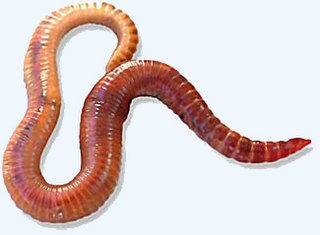Related Research Articles

Vermicompost (vermi-compost) is the product of the decomposition process using various species of worms, usually red wigglers, white worms, and other earthworms, to create a mixture of decomposing vegetable or food waste, bedding materials, and vermicast. This process is called vermicomposting, while the rearing of worms for this purpose is called vermiculture.
Blood worm or bloodworm is an ambiguous term and can refer to:

Bacillus coagulans is a lactic acid–forming bacterial species first isolated and described in 1915 by B.W. Hammer at the Iowa Agricultural Experiment Station as a cause of an outbreak of coagulation in evaporated milk packed by an Iowa condensary. Separately isolated in 1935 and described as Lactobacillus sporogenes in the fifth edition of Bergey's Manual of Systematic Bacteriology, it exhibits characteristics typical of both genera Lactobacillus and Bacillus; its taxonomic position between the families Lactobacillaceae and Bacillaceae was often debated. However, in the seventh edition of Bergey's, it was finally transferred to the genus Bacillus. DNA-based technology was used in distinguishing between the two genera of bacteria, which are morphologically similar and possess similar physiological and biochemical characteristics.

Eisenia fetida, known under various common names such as manure worm, redworm, brandling worm, panfish worm, trout worm, tiger worm, red wiggler worm, etc., is a species of earthworm adapted to decaying organic material. These worms thrive in rotting vegetation, compost, and manure. They are epigean, rarely found in soil. In this trait, they resemble Lumbricus rubellus.

An earthworm is a terrestrial invertebrate that belongs to the phylum Annelida. They exhibit a tube-within-a-tube body plan; they are externally segmented with corresponding internal segmentation; and they usually have setae on all segments. They occur worldwide where soil, water, and temperature allow.

The European nightcrawler is a medium-small earthworm averaging about 1.5 g when fully grown. Generally blueish, pink-grey in color with a banded or striped appearance, the tips of their tails are often cream or pale yellow. When the species has not been feeding, it is pale pink. The species is usually found in deep woodland litter and garden soils that are rich in organic matter in European countries. D. hortensis is sold primarily as a bait worm, but its popularity as a composting worm is increasing.
Verminephrobacter is a genus of Gram-negative bacteria that colonize the nephridia of earthworms within the family Lumbricidae. The first species in the genus, V. eiseniae, was isolated from the earthworm Eisenia foetida, and its description published in 2008. Their closest free-living relatives are bacteria of the genus Acidovorax.
Compostibacillus is a Gram-positive, moderately thermophilic rod-shaped, and spore-forming genus of bacteria from the family of Bacillaceae with one known species. Compostibacillus humi has been isolated from sludge compost from Guangdong in China.
Edaphobacillus is a Gram-positive, aerobic, non-spore-forming and non-motile genus of bacteria from the family of Bacillaceae with one known species.
Halolactibacillus is a Gram-positive, non-spore-forming and motile genus of bacteria from the family of Bacillaceae.
Salisediminibacterium is a genus of Gram-positive bacteria from the family of Bacillaceae. The type species is Salisediminibacterium halotolerans.
Salisediminibacterium halotolerans is a gram-positive, alkalitolerant, and halophilic bacterium from the family Bacillaceae and genus of Salisediminibacterium, which was one of three bacterial strains, and the only novel species, isolated from sediments from the Xiarinaoer soda lake in Mongolia in 2012.
Lysenin is a pore-forming toxin (PFT) present in the coelomic fluid of the earthworm Eisenia fetida. Pore-forming toxins are a group of proteins that act as virulence factors of several pathogenic bacteria. Lysenin proteins are chiefly involved in the defense against eukaryotic and prokaryotic pathogens. Following the general mechanism of action of PFTs lysenin is segregated as a soluble monomer that binds specifically to a membrane receptor, sphingomyelin in the case of lysenin. After attaching to the membrane, the oligomerization begins, resulting in a nonamer on top of membrane, known as a prepore. After a conformational change, which could be triggered by a decrease of pH, the oligomer is inserted into the membrane in the so-called pore state.
Chryseomicrobium excrementi is a Gram-positive, rod-shaped, slightly halotolerant and nitrate-reducing bacterium from the genus of Chryseomicrobium which has been isolated from the cast of an earthworm from the University of North Bengal at Siliguri in India.
Aidingibacillus is a Gram-positive, aerobic non-spore-forming and non-motile genus of bacteria from the family of Bacillaceae with one known species. Aidingibacillus halophilus has been isolated from a salt lake in China.
Aureibacillus is a Gram-positive, strictly aerobic, rod-shaped, spore-forming and motile genus of bacteria from the family of Bacillaceae with one known species. Aureibacillus halotolerans has been isolated from sediments of the northern Okinawa Trough.
Calculibacillus is a Gram-positive, non-spore-forming and strictly anaerobic genus of bacteria from the family of Bacillaceae with one known species. Calculibacillus koreensis has been isolated from sediments of a coal mine in Taebaek.
Numidum is a Gram-positive and facultative anaerobic genus of bacteria from the family of Bacillaceae with one known species which has been isolated from the human gut.
Pueribacillus is a Gram-positive, spore-forming, rod-shaped, aerobic and motile genus of bacteria from the family of Bacillaceae with one known species. Pueribacillus theae has been isolated from Pu'er tea.
References
- 1 2 3 4 "Genus: Pradoshia". lpsn.dsmz.de.
- ↑ "Pradoshia". www.uniprot.org.
- 1 2 3 Saha, Tilak; Ranjan, Vivek K.; Ganguli, Sriradha; Thakur, Subarna; Chakraborty, Biswanath; Barman, Partha; Ghosh, Wriddhiman; Chakraborty, Ranadhir (1 May 2019). "Pradoshia eiseniae gen. nov., sp. nov., a spore-forming member of the family Bacillaceae capable of assimilating 3-nitropropionic acid, isolated from the anterior gut of the earthworm Eisenia fetida". International Journal of Systematic and Evolutionary Microbiology. 69 (5): 1265–1273. doi:10.1099/ijsem.0.003304.